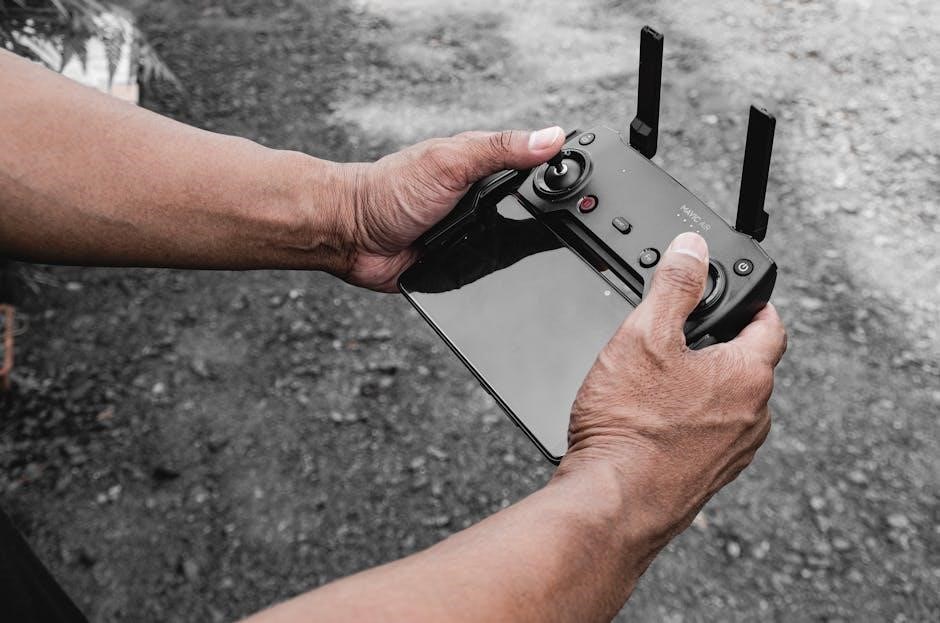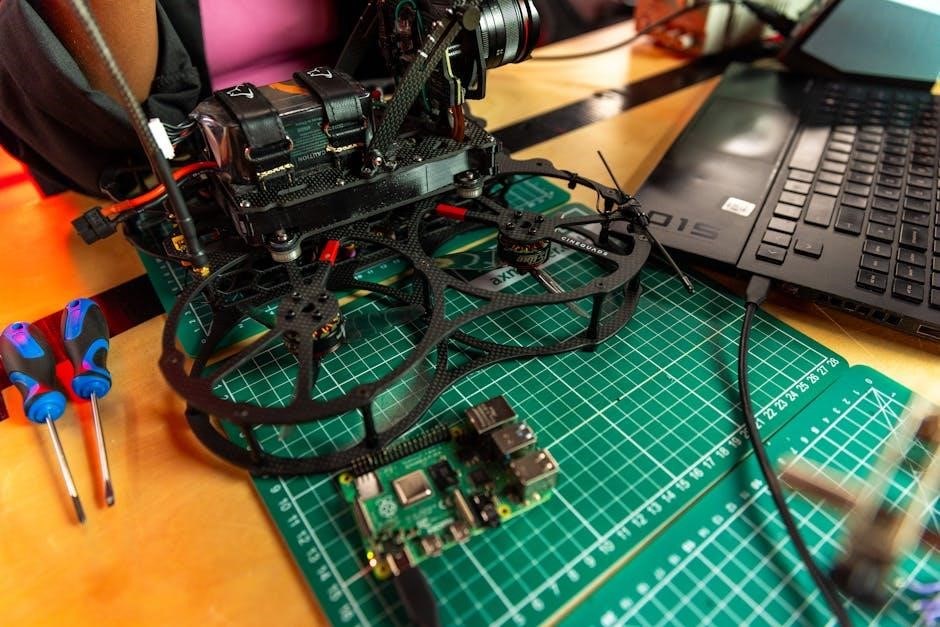A manual boost controller is a mechanical and pneumatic device that regulates turbocharger boost pressure. It allows drivers to adjust and control engine performance manually.

1.1 What is a Manual Boost Controller?
A manual boost controller is a mechanical and pneumatic device designed to regulate boost pressure in turbocharged engines. It allows drivers to manually adjust and control the amount of boost delivered to the engine, optimizing performance. Typically universal, it suits various vehicles and supports boost levels up to 30 PSI. The controller consists of a boost dial, spring, and tubing, enabling precise control over engine power output.
1.2 Importance of Manual Boost Controllers in Turbocharged Engines
Manual boost controllers are crucial for optimizing performance in turbocharged engines. They provide precise control over boost pressure, allowing drivers to adjust power delivery for varying conditions. This enhances engine responsiveness and efficiency. By enabling manual adjustments, these controllers prevent over-boosting, which can damage the engine. They are essential for tuning and maintaining performance, ensuring reliability and peak output in modified or high-performance turbocharged vehicles;

Components of a Manual Boost Controller
A manual boost controller consists of key components like the boost dial, vacuum ports, and spring. These parts work together to regulate boost pressure effectively.
2.1 Key Parts: Boost Dial, Vacuum Ports, and Spring
The boost dial adjusts boost pressure, while vacuum ports connect to the wastegate. The spring determines maximum boost level by resisting pressure. These components work together to regulate turbocharger output, ensuring precise control over engine performance. Proper setup of these parts is essential for optimal functionality and reliability.
2.2 Tubing and Connections: Understanding the Pneumatic System
The pneumatic system relies on precise tubing connections to route boost pressure signals. The boost reference line connects the controller to the turbocharger, ensuring accurate pressure regulation. Properly sealed connections are critical to prevent leaks and maintain consistent boost levels. Understanding the flow through these components is essential for reliable engine performance and optimal turbo functionality.

Understanding the Manual Boost Controller Diagram
The manual boost controller diagram illustrates the components and their connections, providing a clear visual guide for installation and tuning. It simplifies understanding the system.
3.1 Visual Breakdown of the Diagram
The diagram provides a detailed visual representation of the manual boost controller’s components and connections. It highlights the boost reference line, wastegate actuator, and intake manifold ports. The layout shows how vacuum ports and tubing connect to regulate boost pressure. This clear breakdown helps users understand the flow of pressure and how to install and tune the system effectively. It serves as a practical guide for DIY enthusiasts and mechanics alike.
3.2 Flow of Boost Pressure: From Turbo to Engine
The diagram illustrates how boost pressure is generated by the turbocharger and directed to the engine. It flows through the wastegate actuator and intake manifold, with the manual controller regulating the pressure. The vacuum ports and tubing connect to the controller, allowing adjustment of boost levels. This visual guide helps users understand the path of pressure and how to fine-tune it for optimal performance, ensuring proper function and control.
The installation involves mounting the controller, connecting vacuum ports, and routing tubing to the intake manifold. Ensure all connections are secure and leak-free for proper function. Before installing a manual boost controller, gather essential tools like wrenches, screwdrivers, and Teflon tape. Ensure the vehicle is cool to avoid damage. Review the diagram to identify components and connections. Clean the intake manifold and vacuum ports to prevent contamination. Familiarize yourself with the controller’s parts, such as the boost dial and spring. Prepare a workspace with a drain pan for any residual fluids. Double-check all components for damage or wear. Proper preparation ensures a smooth and successful installation process. Mount the manual boost controller securely, ensuring proper alignment with the vacuum ports. Connect the controller to the turbocharger’s wastegate using the provided tubing, following the diagram for correct routing. Attach the boost dial to the controller and adjust the spring tension as needed. Secure all connections tightly to prevent leaks. Finally, test the system to ensure proper function and adjust as necessary before driving. Adjust the boost dial to set the desired boost level, then fine-tune the spring tension for optimal performance, ensuring proper pressure delivery to the engine. Setting the desired boost level involves adjusting the boost dial to achieve the preferred pressure. Turning the dial clockwise increases boost, while counterclockwise decreases it. This adjustment allows precise control over turbocharger performance, ensuring optimal power delivery. Always refer to the manual boost controller diagram for guidance and ensure adjustments align with engine specifications to avoid damage. Proper tuning enhances efficiency and responsiveness. Fine-tuning the spring tension in a manual boost controller ensures precise control over boost levels. Stretching or replacing the spring can increase or decrease boost pressure. Refer to the diagram for guidance on adjusting the spring. Proper tension ensures stable and consistent boost delivery, optimizing engine performance and preventing over-boosting. Adjustments should be made carefully, aligning with the vehicle’s specifications for safe and effective tuning. Over-boosting risks engine damage. Always follow installation guidelines and maintain the system to prevent leaks and ensure safe operation of the manual boost controller. Over-boosting can lead to severe engine damage, including blown head gaskets, cracked pistons, and turbocharger failure. Excessive boost pressures strain engine components, potentially causing catastrophic failure. Always monitor boost levels and avoid exceeding manufacturer recommendations. Proper installation and tuning of the manual boost controller are critical to prevent these risks and ensure reliable engine performance. Proper installation ensures reliable performance and safety. Follow the manual boost controller diagram for correct routing of boost reference lines and vacuum ports. Regularly inspect tubing for leaks and clean filters to maintain airflow. Tighten all connections periodically and ensure the spring tension is appropriate for your boost level. Proper maintenance prevents malfunctions and ensures consistent engine performance under varying conditions. Advanced tuning involves upgrading the spring for higher boost levels and integrating a boost gauge for real-time monitoring. These modifications enhance performance and reliability. Upgrading the spring in a manual boost controller allows for higher boost pressure. Stiffer springs increase the resistance, enabling the turbo to generate more boost. This modification is ideal for performance enthusiasts seeking enhanced power. Ensure proper installation and testing after upgrading to maintain optimal engine performance and avoid over-boosting risks. Integrating a boost gauge provides real-time monitoring of boost pressure, essential for precise tuning. The gauge connects to the manual boost controller, offering visual feedback on pressure levels. This setup helps in maintaining optimal performance and prevents over-boosting. Installation involves connecting the sensor to the controller and mounting the gauge in the cabin for easy viewing during driving. Diagnose low or unstable boost pressure by inspecting the system for leaks or faulty components. Verify connections and ensure proper installation to maintain consistent performance. Low or unstable boost pressure can result from leaks in the system or faulty components. Check all connections, hoses, and the wastegate for proper function. Ensure the boost controller is installed correctly and adjust the spring tension if necessary. Consult the manual boost controller diagram for a clear understanding of the pneumatic connections and components involved in maintaining stable boost levels. Regular maintenance and inspection can prevent such issues and ensure optimal engine performance. Always refer to the diagram for troubleshooting guidance. Leaks in the pneumatic system can cause low or unstable boost pressure. Inspect all tubing and connections for cracks or loose fittings. Use a soapy water solution to detect leaks by applying it to suspect areas. If a leak is found, tighten connections or replace damaged parts. Ensure the boost controller is properly sealed and functioning. Refer to the manual boost controller diagram for a clear view of the system layout to identify potential leak sources and ensure proper repair. Manual boost controllers are essential for optimizing turbocharged engines. Understanding the diagram helps in proper installation and tuning. Apply this knowledge to enhance performance safely. A manual boost controller regulates turbocharger boost pressure, enhancing engine performance. Diagrams simplify installation and tuning, showing components like the boost dial and spring. Proper setup ensures stable boost levels, while adjustments allow customization. Monitoring and maintenance are crucial for optimal function and safety, preventing over-boosting. Understanding these elements helps maximize efficiency and power in turbocharged systems, ensuring reliable operation under various driving conditions. Now that you’ve learned about manual boost controllers, it’s time to apply this knowledge. Start by installing and tuning your controller, using the diagram as a guide. Monitor your engine’s performance and adjust settings to achieve optimal power. Experiment with different boost levels and observe how they impact your vehicle’s behavior. With practice, you’ll master the art of boosting, unlocking your engine’s full potential for enhanced driving experiences.
Installation Steps for a Manual Boost Controller
4.1 Pre-Installation Checklist: Tools and Preparation
4.2 Step-by-Step Installation Process: Mounting and Connecting Components

Adjusting and Tuning the Manual Boost Controller
5.1 Setting the Desired Boost Level
5.2 Fine-Tuning the Spring Tension for Optimal Performance

Safety Considerations and Precautions
6.1 Risks of Over-Boosting and Engine Damage
6.2 Proper Installation and Maintenance Practices

Advanced Tuning and Modifications
7.1 Upgrading the Spring for Higher Boost Levels
7.2 Integrating a Boost Gauge for Real-Time Monitoring

Troubleshooting Common Issues
8.1 Diagnosing Low or Unstable Boost Pressure
8.2 Identifying and Fixing Leaks in the System
9.1 Summary of Key Points
9.2 Encouragement to Apply the Knowledge in Real-World Applications
